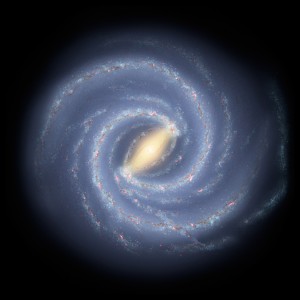
The gold line shows Opportunity’s path of travel on Mars. The start point, its Eagle Crater landing site, is on the top left. And, its current location after traveling a record-setting 40.25 km is shown on the rim of Endeavour Crater. (NASA)
Opportunity Mars Rover Sets Record
Although NASA’s newest Mars rover, Curiosity, has hogged most of the attention since landing on the Red Planet nearly two years ago, Opportunity, the space agency’s Mars rover, which preceded its newer sibling by about 8 years, is the one to set a new record.
Opportunity mission officials said that, after traversing across a little more than 40 kilometers of Martian land, the little Mars rover now holds the off-Earth roving distance record.
On July 27, after a 48 meter excursion, Opportunity’s odometer clicked in at 40.25 kilometers.
“Opportunity driven farther than any other wheeled vehicle on another world,” said, John Callas, the Mars Exploration Rover Project Manager at NASA’s Jet Propulsion Laboratory (JPL) in a press release.
The Soviet Union’s Lunokhod 2 rover, which landed on the Moon in 1973, was the previous record holder racking up a total of about 39 kilometers in less than five months, according to NASA.
Scottish Scientists Precisely Measure Mass of Milky Way
The Milky Way is not as massive as astronomers have long thought, according to a research team led by scientists at Scotland’s University of Edinburgh. The scientists say they reached that conclusion after being able to accurately measure the mass of our Milky Way galaxy for the first time.
The Scottish scientists compared the Milky Way’s mass to that of one of our neighboring galaxies, Andromeda. They determined that our galaxy has about one-half the mass of Andromeda, even though both galaxies have similar spiral-shaped structures and dimensions.
The researchers also calculated the amount of so-called ‘dark matter’ and found that 90 percent of the mass of both galaxies is made up of the mysterious and theoretical substance.

Trees blanket mountains and valleys of southwestern North Carolina in the Nantahala National Forest (USDA)
U.S. Forest Service Says Trees Save Lives
A research project headed up by the U.S. Forest Service has revealed that trees save 850 human lives and prevent 670,000 incidents of acute respiratory symptoms every year.
The new study, recently published in the journal Environmental Pollution, has been described by research officials as the ‘first broad-scale estimate’ of air pollution that has been removed by trees throughout the U.S.
While the study did find that that the tree’s pollution removal improved average air quality by less than 1 percent, research officials said that the effect of that improvement is significant. The researchers estimated the monetary value of human health benefits achieved by the removal of pollution by trees to be about $7 billion each year.

Artist’s impression of ESA’s Gaia spacecraft mapping the stars of the Milky Way ((c) ESA/ATG medialab/ESO)
ESA’s Billion Star Surveyor Gaia Ready to Get to Work
The European Space Agency says that its star surveying spacecraft, Gaia, is finally ready to begin its science mission. The spacecraft has undergone an extensive commissioning process and experienced problems in the months since its December 2013 launch from French Guiana.
The goal of Gaia’s ambitious mission is to chart and create an accurate 3D map of our Milky Way Galaxy. To do so, the spacecraft will make precise measurements of 1 billion stars, which they say is about 1% of the total star population of our galaxy. ESA says that in its mission Gaia will make about 70 observations of each of the 1 billion stars.
Mission officials say that, along with producing the stereoscopic and kinematic census of the 1 billion targets stars within the Milky Way, Gaia will be able to provide scientists with valuable data concerning composition, formation and evolution of our Galaxy.
Newborns Can Smell Mother’s Fears
Newborn babies can quickly learn what to fear by simply smelling the odor of their distressed mothers.
That’s according to a team of scientists from the University of Michigan Medical School and New York University.
And, the fears that are picked up by the little ones aren’t necessarily ‘natural’ fears but those that are unique to each individual mother.
For example, if the child’s mother happened to experience a particular traumatic event during pregnancy and as a result developed a specific fear, she could communicate that fear through an odor she emits whenever she feels fear allowing her newborn to also quickly learn that fear.
The researchers said that their findings could perhaps explain how a traumatic event experienced by a mother long before giving birth can deeply affect her children, which is something that has mystified mental health experts for years.























Comments are closed.